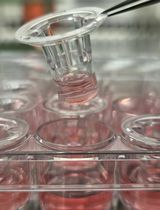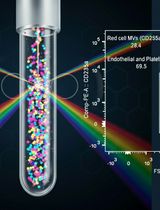- EN - English
- CN - 中文
Functional Phenotyping of Lung Mouse CD4+ T Cells Using Multiparametric Flow Cytometry Analysis
使用多参数流式细胞术分析小鼠肺 CD4+ T 细胞的功能表型
发布: 2023年09月20日第13卷第18期 DOI: 10.21769/BioProtoc.4815 浏览次数: 4096

相关实验方案

研究免疫调控血管功能的新实验方法:小鼠主动脉与T淋巴细胞或巨噬细胞的共培养
Taylor C. Kress [...] Eric J. Belin de Chantemèle
2025年09月05日 3445 阅读

外周血中细胞外囊泡的分离与分析方法:红细胞、内皮细胞及血小板来源的细胞外囊泡
Bhawani Yasassri Alvitigala [...] Lallindra Viranjan Gooneratne
2025年11月05日 1328 阅读
Abstract
Gammaherpesviruses such as Epstein-Barr virus (EBV) are major modulators of the immune responses of their hosts. In the related study (PMID: 35857578), we investigated the role for Ly6Chi monocytes in shaping the function of effector CD4+ T cells in the context of a murine gammaherpesvirus infection (Murid gammaherpesvirus 4) as a model of human EBV. In order to unravel the polyfunctional properties of CD4+ T-cell subsets, we used multiparametric flow cytometry to perform intracellular staining on lung cells. As such, we have developed herein an intracellular staining workflow to identify on the same samples the cytotoxic and/or regulatory properties of CD4+ lymphocytes at the single-cell level. Briefly, following perfusion, collection, digestion, and filtration of the lung to obtain a single-cell suspension, lung cells were cultured for 4 h with protein transport inhibitors and specific stimulation media to accumulate cytokines of interest and/or cytotoxic granules. After multicolor surface labeling, fixation, and mild permeabilization, lung cells were stained for intracytoplasmic antigens and analyzed with a Fortessa 4-laser cytometer. This method of quantifying cytotoxic mediators as well as pro- or anti-inflammatory cytokines by flow cytometry has allowed us to decipher at high resolution the functional heterogeneity of lung CD4+ T cells recruited after a viral infection. Therefore, this analysis provided a better understanding of the importance of CD4+ T-cell regulation to prevent the development of virus-induced immunopathologies in the lung.
Key features
• High-resolution profiling of the functional properties of lung-infiltrating CD4+ T cells after viral infection using conventional multiparametric flow cytometry.
• Detailed protocol for mouse lung dissection, preparation of single-cell suspension, and setup of multicolor surface/intracellular staining.
• Summary of optimal ex vivo restimulation conditions for investigating the functional polarization and cytokine production of lung-infiltrating CD4+ T cells.
• Comprehensive compilation of necessary biological and technical controls to ensure reliable data analysis and interpretation.
Graphical overview

Graphical abstract depicting the interactions between immune cells infiltrating the alveolar niche and the lung during respiratory infection with a gammaherpesvirus (Murid herpesvirus 4, MuHV-4). Two distinct situations are represented: the inflammatory response developed during viral replication in the lung, either in the presence (WT mice) or absence of regulatory monocytes (CCR2KO mice). Sequential process of the experiment is represented, starting from intratracheal instillation of MuHV-4 virions to tissue dissociation and multicolor staining for flow cytometry analysis.
Background
The complexity and heterogeneity of CD4+ T cells are increasingly being investigated. Indeed, in addition to their multiple roles as helper cells orchestrating the orientation of immune responses, CD4+ T cells also play major direct roles as regulatory or cytotoxic cells. In particular, it is becoming increasingly clear that CD4+ T cells, alongside with CD8+ T cells, are key determinants in anti-viral and anti-tumor immunity. Investigating the heterogeneity of CD4+ T-cell response, as well as their possible plasticity in different contexts of inflammation, can be achieved by high-resolution transcriptomic approaches such as sc-RNA sequencing. However, this expensive technique, relying on strong bioinformatics expertise, cannot always be used as a first line of investigation and/or requires additional validation of protein expression. In this context, the development of multicolor flow cytometry staining is a reliable and accurate tool as it allows the precise definition of the expression profile of surface molecules, while evaluating the functional properties of these populations in the presence of relevant stimuli. Multiparametric flow cytometry is therefore a widely used method for immunoprofiling circulating or tissue-resident cells. The originality and interest of the present protocol is to combine the staining of surface molecules suggestive of functional cell polarization (e.g., the checkpoint inhibitor PD-1 or the degranulation marker CD107a) with the quantification of the immune mediators expressed and/or released by these target cells. In that regard, the design of the restimulation cocktail is extremely important and requires a precise knowledge of the biological context of expression of each particular mediator. Indeed, the use of certain drugs such as phorbol 12-myristate 13-acetate and ionomycin triggers a massive and non-specific release of certain cytokines that does not necessarily reflect the behavior and level of activation of the cells of interest in vivo and makes it difficult to interpret the results. In addition, these aggressive treatments may also introduce a bias by affecting cell viability and leading to the selective loss of activated cells in vivo and therefore more sensitive to this type of treatment. Furthermore, while staining of some chemokines such as CXCL9 or cytotoxic mediators such as granzyme B can be achieved directly without any accumulation, others require simple accumulation (e.g., iNOS) or accumulation in presence of conditioned medium (e.g., IFNγ) for reliable detection. More specifically, the protocol presented here details the optimal conditions for assessing the regulatory vs. cytotoxic properties of CD4+ T cells recruited to the lung after respiratory infection with a gammaherpesvirus.
Materials and reagents
GentleMACS C tube (Miltenyi, catalog number: 130-093-237)
Hank’s buffered saline solution (HBSS) (Lonza, catalog number: BE10-543F)
DNase I (Roche, catalog number: 11284932001)
Collagenase D (Roche, catalog number: 11088866001)
Falcon, 15 and 50 mL conical centrifuge tubes (Corning, catalog numbers: 352096 and 352070)
Bovine serum albumin (BSA) (Sigma, catalog number: A8412)
Fetal calf serum (FCS) (Gibco, catalog number: 10082147)
EDTA (CorningTM, catalog number: 46-034-CI)
Falcon® 70 μm cell strainer (Corning, catalog number: 352350)
cOmpleteTM protease inhibitor cocktail (Roche, catalog number: 11697498001)
RBC lysis buffer (Thermo Fisher Scientific, catalog number: 00433357)
Trypan Blue solution, 0.4% (Sigma-Aldrich, catalog number: 93595)
96-well round (U) bottom plate, TC surface, pack of 1 (Thermo ScientificTM, catalog number: 163320)
RPMI 1640 medium (GibcoTM, catalog number: 11875093)
Monensin solution (BioLegend, catalog number: 420701)
Brefeldin A solution (BioLegend, catalog number: 420601)
β-mercaptoethanol (Sigma-Aldrich, catalog number: 3148)
L-Glutamine (CorningTM, catalog number: 25005CI)
Sodium pyruvate (CorningTM, catalog number: 25-000-CIR)
Sodium azide (Sigma, catalog number: 8223350100)
Penicillin-streptomycin (GibcoTM, catalog number: 15070063)
Purified anti-mouse CD28 antibody (BioLegend, catalog number: 102102)
Ultra-LEAFTM purified anti-mouse CD3ε antibody (BioLegend, catalog number: 100340)
Ultra-LEAFTM purified anti-mouse CD49d antibody (BioLegend, catalog number: 103709)
Anti-mouse CD107a allophycocyanin (APC) conjugated antibody (BioLegend, catalog number: 121613)
Anti-mouse CD16/32 Fc block (BioLegend, catalog number: 101301)
Zombie Aqua Fixable Viability kit (BioLegend, catalog number: 423101)
Paraformaldehyde (PFA) (Santa Cruz Biotechnology, catalog number: sc-281692)
Saponin (Sigma-Aldrich, catalog number: 47036)
BD FACSuiteTM CS&T research beads (BD Biosciences, catalog number: 650621)
Lung digestion medium (see Recipes)
Collagenase D working stock (see Recipes)
DNase I working stock (see Recipes)
Culture medium (see Recipes)
Wash buffer (see Recipes)
FACS buffer (see Recipes)
Permeabilization buffer (see Recipes)
Intracellular staining buffer (see Recipes)
Fc receptor blockade (see Recipes)
Intracellular staining mix (see Recipes)
Surface staining mix (see Recipes)
Zombie VioletTM Fixable Viability Kit (see Recipes)
Restimulation medium 1 (see Recipes and Table 1)
Restimulation medium 2 (see Recipes and Table 1)
Table 1. Summary of the specific cocktails of stimulation medium
Specific medium Milieu a (Il-10 and IFNγ producing T cells) Milieu b (Granzyme B and Granzyme A producing T cells) Milieu c (Perforin-1 producing T cells) Media RPMI complete medium RPMI complete medium RPMI complete medium Protein transport inhibitors Monensin (2 μM) and brefeldin (2 μM) Monensin (2 μM) and brefeldin (2 μM) Monensin (2 μM) and brefeldin (2 μM) Additives β-mercaptoethanol (50 μM) β-mercaptoethanol (50 μM) β-mercaptoethanol (50 μM) purified CD28 antibody (1 μg/mL) purified CD28 antibody (1 μg/mL) purified CD3ε antibody (2 μg/mL) purified CD3ε antibody (2 μg/mL) purified CD49d antibody (1 μg/mL) APC anti-mouse CD107a (0.5 μg/mL; LAMP-1) antibody
Recipes
Lung digestion medium
HBSS medium supplemented with 5% heat-inactivated fetal calf serum
Collagenase D working stock
Resuspend lyophilized collagenase D with HBSS at a concentration of 20 mg/mL (stock solution). The reconstituted solution can be stored at -15 to -25 °C.
DNase I working stock
Resuspend lyophilized DNase I with nuclease-free water at a concentration of 1 mg/mL (stock solution). The reconstituted solution can be stored at -15 to -25 °C.
Culture medium
RPMI medium supplemented with 10% heat-inactivated FCS, 100 U/mL penicillin, 100 U/mL streptomycin, 2 mM L-glutamine, and 50 μM of β-mercaptoethanol.
Wash buffer
2 mM PBS-EDTA with 10% FCS
FACS buffer
PBS, 0.5% BSA, EDTA 2 mM, 2 mM NaN3 sodium azide
Note: FACS Buffer is a buffered saline solution that can be used for immunofluorescence staining protocols, antibody and cell dilution steps, wash steps required for surface staining, and flow cytometry analysis. The buffer contains sodium azide as preservative and animal serum proteins (BSA) to help minimize non-specific binding of antibodies. The addition of EDTA prevents cell-to-cell adhesion and clumping.
Permeabilization buffer
PBS, 0.1% saponin
Intracellular staining buffer
FACS buffer, 0.1% saponin
Fc receptor blockade
Add purified anti-mouse CD16/32 antibody diluted 1:500 in FACS buffer. Put 100 μL of total volume per well.
Surface staining mix
Add antibodies with appropriate dilutions predetermined by titration experiments in FACS buffer. Put 100 μL of total volume per well.
Zombie VioletTM Fixable working stock
Place the DMSO provided with the kit in a 37 °C water bath until it is completely thawed. Add 100 μL of DMSO to one vial of Zombie VioletTM dye and mix until fully dissolved. Store at -20 °C in 10 μL aliquots. Add appropriate volumes of Fixable Viability solution, with dilutions predetermined by titration experiments (1:1,000) in PBS. Put 100 μL of total volume per well.
Intracellular staining mix
Add antibodies with appropriate dilutions predetermined by titration experiments in intracellular staining buffer. Put 100 μL of total volume per well.
Equipment
BD LSR Fortessa X-20 flow cytometer (BD Biosciences)
Beckman Coulter Allegra X-15R centrifuge (Beckman Coulter); μ-plate carrier for SX4750A (392806)
GentleMACS dissociator (Miltenyi)
Software
FACS Diva software (Version 6.0)
FlowJo software v10
Procedure
文章信息
版权信息
© 2023 The Author(s); This is an open access article under the CC BY-NC license (https://creativecommons.org/licenses/by-nc/4.0/).
如何引用
Readers should cite both the Bio-protocol article and the original research article where this protocol was used:
- Maquet, C. M., Gillet, L. and Machiels, B. (2023). Functional Phenotyping of Lung Mouse CD4+ T Cells Using Multiparametric Flow Cytometry Analysis. Bio-protocol 13(18): e4815. DOI: 10.21769/BioProtoc.4815.
- Maquet, C., Baiwir, J., Loos, P., Rodriguez-Rodriguez, L., Javaux, J., Sandor, R., Perin, F., Fallon, P. G., Mack, M., Cataldo, D., et al. (2022). Ly6Chimonocytes balance regulatory and cytotoxic CD4 T cell responses to control virus-induced immunopathology. Sci. Immunol. 7(73): eabn3240.
分类
免疫学 > 免疫细胞功能 > 淋巴细胞
细胞生物学 > 基于细胞的分析方法 > 流式细胞术
您对这篇实验方法有问题吗?
在此处发布您的问题,我们将邀请本文作者来回答。同时,我们会将您的问题发布到Bio-protocol Exchange,以便寻求社区成员的帮助。
Share
Bluesky
X
Copy link










